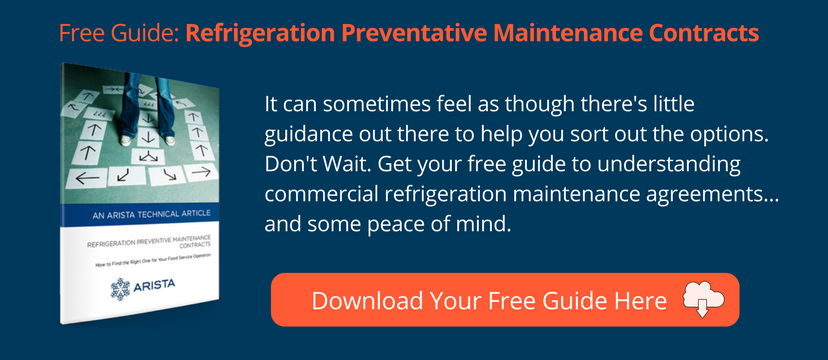Your NYC health inspection grade is one of the most visible (and powerful) forms of promotion about your restaurant. After all, your rating is plastered right there in your front window, where every customer and passer-by can see it. All NYC ratings are also published in the New York Times. That’s why, if you do poorly on your restaurant heath inspection, at best it’s a PR nightmare. And in the worst case, you could be facing fines and even a shutdown.
The health inspector rarely announces himself in advance. So how can you be sure you’ll have all your ducks in a row when he shows up during a busy lunch shift when you’ve just accepted a large delivery? It’s about being prepared at all times.
Here at Arista, we have been servicing NYC restaurants for decades. We’ve seen how to most successful NYC restaurants are doing it right. Here are 12 of our most useful restaurant health inspection preparation tips.
Top 12 restaurant health inspection readiness tips
1. Perform a regular self-inspection
At least once every month or so, try stepping into the shoes of the health inspector. Take a good objective look at every part of your restaurant, inside and out. If you possibly can, try to get a copy of the actual restaurant health inspection forms. Then use that as a guide to make a note of any areas in your restaurant that need work.
2. Review findings from past restaurant health inspections
Schedule regular staff meetings where you share the results of your self-inspection, plus findings from your last restaurant health inspection by the city. Doing this on a regular basis helps employees to understand how important your health grade rating is to the success of your restaurant.
Does your restaurant have any staff members that don’t speak English well? If so, it’s tempting to rely on other bilingual staff to translate or, worse, leave them out of the discussion altogether. This is a mistake! You must ensure that ALL employees fully understand the importance of cleanliness, hygiene, as well as food safety procedures. If necessary, consider hiring professional translators.
3. Train ALL employees
To keep your customers safe as well as be ready for a restaurant health inspection, managers and any employees involved in handling food should be properly trained in safe practices. Managers can find courses, take exams and get certified through the National Restaurant Association’s ServSafe website. They can also learn to teach training courses to your other employees that handle food.
4. Verify safe food temperatures
Maintain ongoing procedures for regularly verifying safe food temperatures, from the time ingredients are delivered from vendors until your prepared foods are served to customers. This is one of the most critical aspects of the restaurant health inspection! Here are some essentials:
- Keep cold food below 40 degrees F, hot food above 60 degrees F, and frozen food below 0 degrees F (check your local regulation for more information).
- Make sure all refrigeration and freezer boxes have properly calibrated thermometers.
- Use probe thermometers to check internal temperatures when cooking hazardous items like meat.
5. Get a refrigeration tune up
The reliable functioning of your refrigerators and freezers is essential to nailing your restaurant health inspection. To keep your food safe and make sure you keep earning that “A” NYC health grade, it’s not enough to place thermometers in your equipment and check periodically to make sure they are at the correct temperature.
To keep your refrigeration units running reliably, bring in a professional to have them thoroughly cleaned, inspected and tuned up. Thermometers need to be calibrated, coils need to be cleaned, fans and blades cleaned and tuned up, and door gaskets inspected and replaced if needed.
6. Professionally clean ice machines
When it comes to food safety, your ice machine is one of the most dangerous things in your restaurant. That’s why you need to have it regularly taken apart, inspected, thoroughly cleaned and disinfected by refrigeration experts. You must do this at least twice per year. Don’t skip this step or face the consequences at your next restaurant health inspection.
Learn more:
Bacteria in Ice: Think Your Restaurant’s Ice Is Safe?
7. Deep clean problem areas
Use your recent reports from the health inspector (as well as your own self-inspection results) as a guide to making cleaning improvements in your kitchen, server stations, bathrooms, storage and cooler areas.
8. Monitor pest control
Choose a pest control service that reminds you to do regular inspections and service at the required intervals. And be sure to keep the service reports handy to show the health inspector during your next restaurant health inspection.
9. Check water temperature
Water temperatures in dishwashers and other equipment must meet health department standards to earn you that “A” grade on your restaurant health inspection. Make sure that both dishwashers and hot water heaters are reaching the required temperature.
10. Check drains
A slow or poorly-functioning drain in your kitchen or bathroom screams poor sanitation. Get a plumber in right away of you find any drains that need attention.
11. Check condition of waste receptacles
Make sure your kitchen staff are removing food prep waste on a timely basis and following proper procedures. Also, routinely check the condition of receptacles to be sure they remain leak-proof, pest-proof and have tightly closing lids.
12. Be vigilant about personal hygiene
This is another big food safety issue, and it’s critical for preparing for your restaurant health inspection. Cross contamination can happen when kitchen staff fail to properly wash between performing cooking tasks, or after using the bathroom. Make sure your staff knows that this is a zero-tolerance issue, and be sure to always provide sufficient hot & cold running water, soap in dispensers, sanitizer, and paper towels in the kitchen serving and prep stations, and rest rooms.
Learn more:
6 Ways You’re Jeopardizing Your Restaurant’s NYC Health Grade


